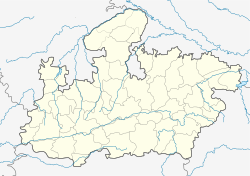Orchha Fort complex
| Orchha Fort complex | |
|---|---|
| Orchha, Madhya Pradesh, India | |

View of the fort complex and bridge
|
|
| Coordinates | 25°21′N 78°38′E / 25.35°N 78.64°E |
| Type | Fort |
| Site information | |
| Open to the public |
Yes |
| Condition | Abandoned |
| Site history | |
| Built | 16–17 th century |
| Materials | Stone, brick and mortar |
The Orchha Fort complex, which houses a large number of ancient monuments consisting of the fort, palaces, temple and other edifices, is located in the Orchha town in the Indian state of Madhya Pradesh. The fort and other structures within it were built by the Bundela Rajputs starting from early 16th century by King Rudra Pratap Singh of the Orchha State and others who followed him.
The fort complex, which is accessed from an arched causeway, leads to a large gateway. This is followed by a large quadrangular open yard surrounded by palaces. These are Raja Mahal or Raja Mandir, Sheesh Mahal, Jahangir Mahal, a temple, gardens and pavilions. The battlements of the fort have ornamentation. Notable architectural features in the fort complex are projected balconies, open flat areas and decorated latticed windows.
The fort complex is located in the Tikamgarh district of Madhya Pradesh in the erstwhile state of Orchha. The fort complex is within an island formed by the confluence of the Betwa River and Jamni River in Orchha town. Approach to the complex from the eastern part of the market in the town is through a multiple arched bridge with 14 arches built in granite stones.
Orchha town is approximately 80 kilometres (50 mi) away from Tikamgarh town, which is the district headquarters of the district of the same name. Jhansi town is 15 kilometres (9.3 mi) away. Orchha is a railway station of the Central Railway on the Jhansi-Manikpur section.
The fort was built following the founding of the Orchha State in 1501 AD by Rudra Pratap Singh (r. 1501–1531), a Bundela rajput. The palaces and temples within the fort complex were built over a period of time by successive Maharajas of the Orchha State. Of these, the Raja Mandir or Raja Mahal was built by Madhukar Shah who ruled from 1554 to 1591. Jahangir Mahal and Sawan Bhadon Mahal were built during the reign of Vir Singh Deo (r. 1605–1627). The features of "pepper pots and domes" seen in the fort complex are believed to have inspired Lutyens in the architecture of the structures which he built in New Delhi.
...
Wikipedia


